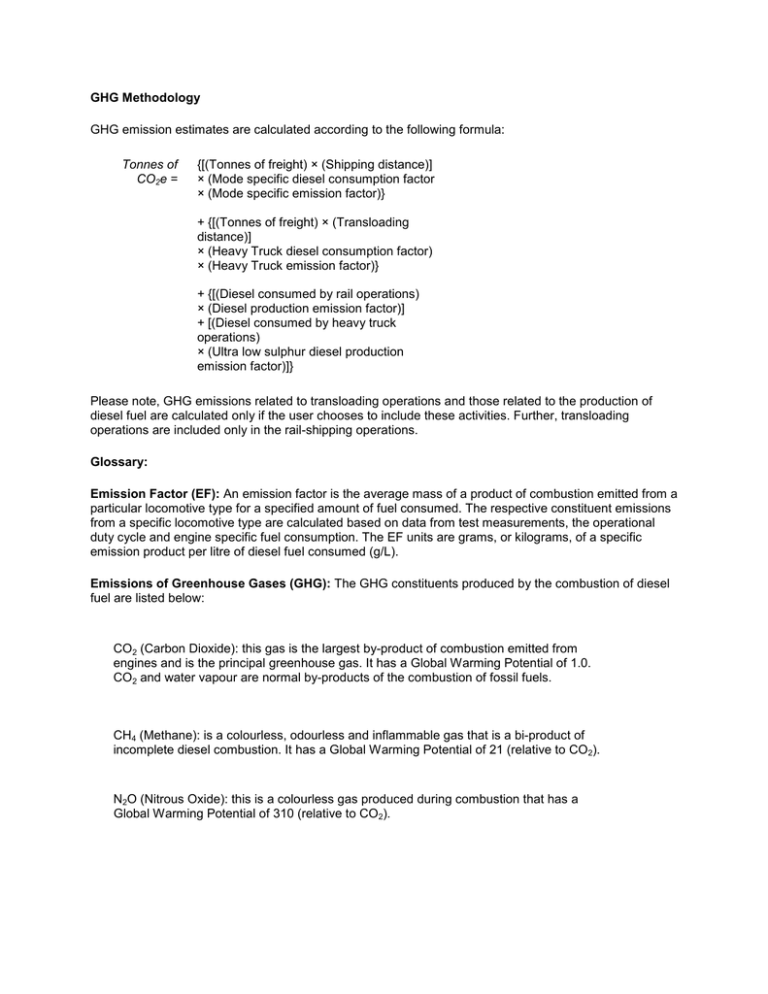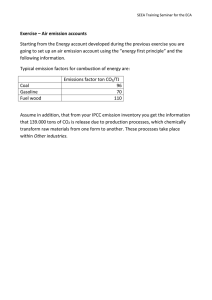Methodology (PDF 22KB) - Railway Association of Canada
advertisement

GHG Methodology
GHG emission estimates are calculated according to the following formula:
Tonnes of
CO2e =
{[(Tonnes of freight) × (Shipping distance)]
× (Mode specific diesel consumption factor
× (Mode specific emission factor)}
+ {[(Tonnes of freight) × (Transloading
distance)]
× (Heavy Truck diesel consumption factor)
× (Heavy Truck emission factor)}
+ {[(Diesel consumed by rail operations)
× (Diesel production emission factor)]
+ [(Diesel consumed by heavy truck
operations)
× (Ultra low sulphur diesel production
emission factor)]}
Please note, GHG emissions related to transloading operations and those related to the production of
diesel fuel are calculated only if the user chooses to include these activities. Further, transloading
operations are included only in the rail-shipping operations.
Glossary:
Emission Factor (EF): An emission factor is the average mass of a product of combustion emitted from a
particular locomotive type for a specified amount of fuel consumed. The respective constituent emissions
from a specific locomotive type are calculated based on data from test measurements, the operational
duty cycle and engine specific fuel consumption. The EF units are grams, or kilograms, of a specific
emission product per litre of diesel fuel consumed (g/L).
Emissions of Greenhouse Gases (GHG): The GHG constituents produced by the combustion of diesel
fuel are listed below:
CO2 (Carbon Dioxide): this gas is the largest by-product of combustion emitted from
engines and is the principal greenhouse gas. It has a Global Warming Potential of 1.0.
CO2 and water vapour are normal by-products of the combustion of fossil fuels.
CH4 (Methane): is a colourless, odourless and inflammable gas that is a bi-product of
incomplete diesel combustion. It has a Global Warming Potential of 21 (relative to CO2).
N2O (Nitrous Oxide): this is a colourless gas produced during combustion that has a
Global Warming Potential of 310 (relative to CO2).
The sum of the constituent greenhouse gases expressed in terms of their equivalents to the Global
Warming Potential of CO2 is depicted as CO2 equivalent (CO2e). This is calculated by multiplying the
volume of fuel consumed by the Emission Factor of each constituent then, in turn, multiplying the product
by the respective Global Warming Potential, and summing them.
Class I Railway: A railway company with gross revenues of $250,000,000 a year from Canadian rail
service.
Short Line Railway: A railway that may originate or terminate freight traffic on its track, participate in
division of revenue, and is usually less than 100 miles in length.
Transloading: The transfer of freight from one mode to another is known as transloading. In the case of
the "RAC GHG Calculator" transloading operations refer to shipment of freight by heavy truck from point
of origin to a transloading facility where it is loaded onto a railcar prior to rail shipment, as well as
shipment by heavy truck from a transloading facility to the final destination subsequent to rail shipment.
Conversion Factors Related to Railway Operations
Imperial gallons to litres
U.S. gallons to litres
Litres to Imperial gallons
Litres to U.S. gallons
Miles to kilometres
Kilometres to miles
Metric tonnes to tons (short)
Tons (short) to metric tonnes
Revenue ton-miles to Revenue tonne-kilometres
Revenue tonne-kilometres to Revenue ton-miles
4.5461
3.7853
0.2200
0.2642
1.6093
0.6214
1.1023
0.9072
1.4599
0.6850
Sources:
Environment Canada (2007), Canada's
Heavy truck and rail
Greenhouse Gas Inventory 1990 - 2005,
emission factors
Table A12-7
Adapted from Natural Resources Canada
Heavy truck diesel
(2000), Fuel Efficiency Benchmarking in
consumption factor
Canada's Trucking Industry
Diesel production
Adapted from, GHGenius version 3.11
emission factors
Rail fuel
Derived from figures from the Railway
consumption factors Association of Canada internal database
Disclaimer:
Please be advised that the GHG emissions calculated with the Railway Association of Canada's
Greenhouse Gas Calculator are intended to be used only as an estimate. It is recommended that
shippers discuss the issue with their freight service providers prior to shipping.
Further, it should be noted that entering unusually low or high values in the input fields of the "RAC GHG
Calculator" may result in inaccuracies.


